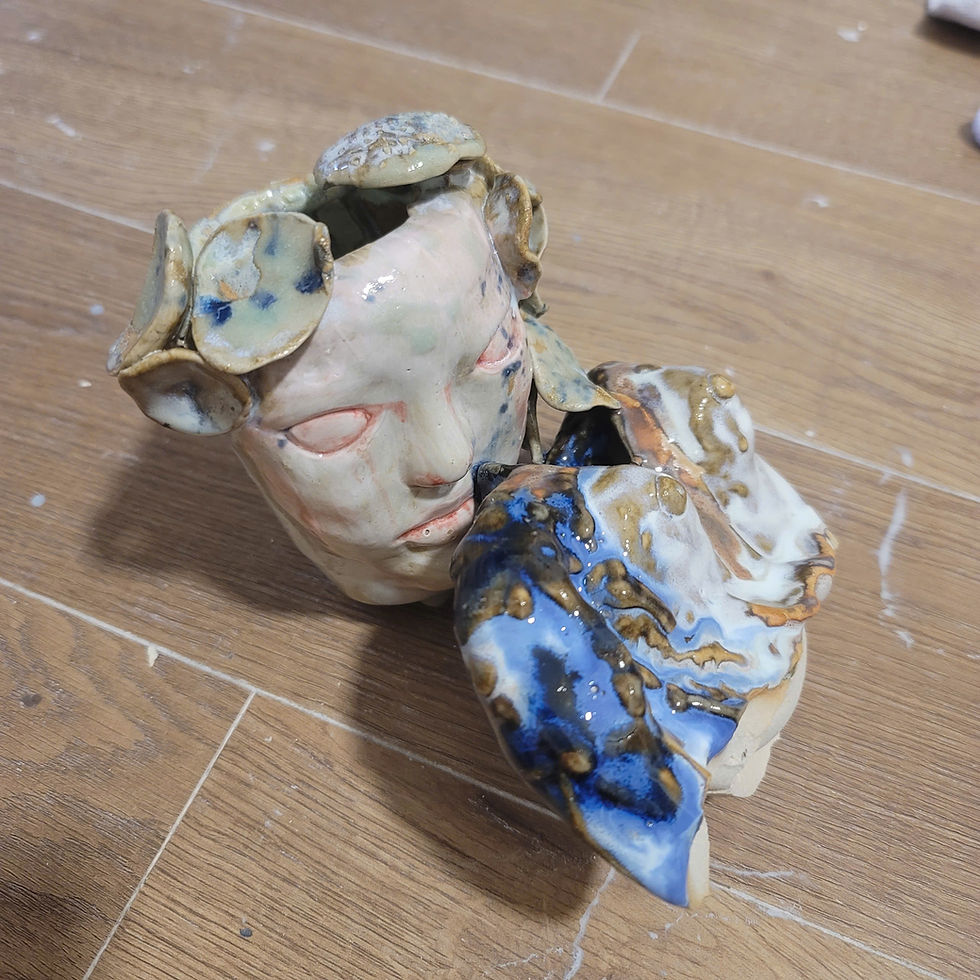The fragile sorrow of ceramics
- Hand Fetish Projects

- Oct 30, 2024
- 3 min read
Updated: Jan 5
On a day of rain and storm in October

Since I began shaping clay, I’ve shattered countless vessels. It’s a peculiar privilege to destroy one’s own creation. I emphasize ‘one’s own’. Purchased ceramics are merely ‘half-mine’. The buyer only knows them from the moment of purchase, when they spot them on a supermarket shelf or while scrolling through online markets, bathed in the soft, ambiguous glow of spotlights and price tags. In a fleeting moment of consumerism, they're oblivious to the craftsmanship or the alchemy that lent the piece its hue. Such ceramics are born into existence only to meet their demise, confined to the buyer's limited perception. Anything whose past remains a mystery can never truly be ‘mine’, according to my idiosyncratic philosophy.
I've broadened my definition of shattering a ceramic piece beyond the simple act of dropping it. There are countless ways for ceramics to succumb to ruin. A piece can fracture before it's even classified as ceramic, a nameless, sorrowful demise. Theoretically, a ceramic piece undergoes three stages before assuming its identity: bone dry - completely devoid of moisture; bisque-fired - low-temperature fired to harden it for decoration, a sort of ceramic adolescence; and finally, glaze-fired - subjected to high heat after being coated with a glaze, a fully matured ceramic capable of holding liquid without leaking, much like a complex adult psyche striving to maintain its composure. At any stage of this maturation, a piece can be shattered. The average buyer can only break fully mature ceramics.
Therefore, I take pride in shattering ceramics in more profound and varied ways. I can frequently destroy ceramics that are truly 'mine', from the adolescent to the mature. I shatter them during shaping due to a heavy hand. I shatter them after bisque firing due to impatience and a failure to let them dry completely. And even if they manage to survive unscathed, I can still reduce them to shards if they fail to meet my aesthetic standards. It's still a more glorious end compared to purchased ceramics. It's a tragedy for those mass-produced ceramic cups, bought and broken, only to be forgotten as if they had never existed. The first encounter with such objects must be linked to a memory to be remembered, but not everyone has a memorable first encounter.
Everything has a beginning. And the first time one breaks a ceramic is no different. Often, the initial memory associated with owning a ceramic piece is linked to the act of sipping tea or coffee. At that point, one is old enough to remember that first moment, along with the accompanying heartbreak if the piece was shattered. If it was a gift, the broken ceramic is accompanied by regret. But the first time breaking a ceramic that is truly 'yours' is a particularly painful experience (I'm referring to breaking ceramics during their transition from adolescence to maturity). The hands ache from the sharp ceramic shards, and the heart aches from the hours of investment and anticipation that have been reduced to rubble. Ceramics broken in the kiln produce sharper and tinier shards compared to those shattered by a fall. I lack a scientific explanation for this, perhaps it's because the explosive force within the kiln is greater than the force of gravity.
Sometimes, I deliberately shatter my own ceramics. Often, it's because the white glaze isn't pure enough. I can't simply discard it in the trash due to the risk of being caught by the janitor. Every flaw has a root cause, often traceable to some form of carelessness. I'm constantly haunted by the fear of someone discovering my imperfections in the trash. In the world of ceramics, technique is as crucial as artistry, and any carelessness must be atoned for. Ceramics embody the concept of karma, and this particular kind of karma is far swifter than waiting for a careless individual to face misfortune. Therefore, I find great satisfaction in uncovering the reasons behind the cracks in my ceramics.
Occasionally, I shatter ceramics, just as I occasionally feel sorrow. Both are part of the human experience. Glazes behave unpredictably during firing, and no one can foresee the outcome. If a piece doesn't meet expectations, it must be broken. Each firing is a gamble. The anticipation is exhilarating, but the aftermath can be filled with despair.
Nevertheless, it's still 2024, and I'm destined to shatter countless ceramics and hearts in my lifetime.




Comments